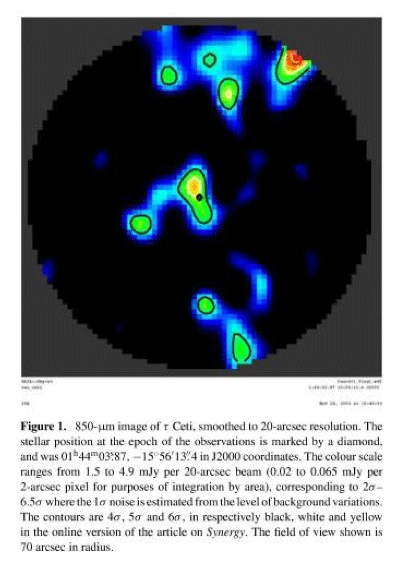Tau Ceti has street cred. Lying only 11.9 light years away, it is the second-closest single G-type star. It’s older than the Sun, and photometrically quiet. It’s naked-eye visible from both hemispheres, ensuring VIP seating at any SETI fundraiser.
And so what about planets? It’s been clear for a few years that Tau Ceti has a zeroth-order dissimilarity with the solar system. That is, if it had a Jovian-mass planet in a Jovian-like orbit, a press conference would have been dedicated to it several years ago. Indeed, because it is so bright and so quiet, Tau Ceti is among the handful of stars in the sky that are best suited to long-term high-precision monitoring via the Doppler velocity technique. It’s at or near the top of the list for all of the major Doppler surveys.
Tau Ceti displays a marked excess luminosity in the far-infrared. Blotchy sub-millimeter images imply that this excess luminosity arises from a wide ring of cold dust at Pluto-like distances from the star. In this picture, the radiating dust arises from ongoing collisions within a Kuiper belt-like disk comprising roughly an Earth-mass worth of icy asteroidal bodies:
Tau Ceti’s Kuiper belt seems to be about ten times more massive than our own Kuiper belt, despite the fact that Tau Ceti’s metallicity is only about one-third that of the Sun. There’s little risk in hypothesizing (read hand-waving) that the low metallicity of Tau Ceti’s protoplanetary disk meant slow growth for Tau Ceti’s retinue of proto-Jovian cores, which subsequently missed out on rapid gas accretion. The ensuing presence of Neptunes, and the concomitant absence of a Jupiter, generated a different dynamical history compared to the Solar System’s — namely one with more stuff left over at the end of the day in the icy outer reaches.
Given this picture, the a-priori odds are excellent that Tau Ceti resembles tens of billions of ordinary, single Population I stars in the galaxy and also harbors multiple inner planets with masses between Earth and Neptune, on nearly circular, nearly co-planar orbits with periods of 100 days or less. Should such worlds exist in orbit around Tau Ceti, then it’s likely that sufficient radial velocity data now exist to dig them out…
Readers surely noticed the paper by Mikko Tuomi and colleagues that was posted to astro-ph earlier this month. Tuomi and collaborators report on a joint analysis of three large-N data sets that comprise thousands of radial velocity measurements (from HARPS, KECK and AAT) spanning a total time base line in excess of 13 years. Ideally, one would like have a fully definitive conclusion emerge from such a massive data set, but frustratingly, Tau Ceti is holding its cards very close to the vest, and as radial velocity half-amplitudes inexorably drop below K=1 m/s, this will be an increasingly common behavior from other nearby high-value stars. In their arXiv preprint, Toumi et al. lay off their risk and remain ambiguous regarding actual detections of actual planets, providing only a fully hedged speculation at the end of the abstract, that these “periodicities could be interpreted as corresponding to planets…”
The modeling strategy for Tau Ceti taken in the Tuomi et al. paper provides an alternative to the approach adopted by Dumusque et al. in digging the K=0.5 m/s Alpha Cen Bb out of a similarly challenging data set. For both systems, the authors adopt the stance that it is no longer sufficient to write off excess scatter in radial velocity fits as “stellar jitter”. Dumusque’s team developed a physical model for starspot activity migrating latitudinally on a differentially rotating star, and also modeled the convective blueshift arising from stellar activity. Application of these physical models spurred the removal of systematic “noise” from the time series, thereby revealing a candidate Earth-mass planet in a 3.2-day orbit. Tuomi et al. excavate five potential planets by exploring the use of ARMA(p,q) — AutoRegressive Moving Average — models which recognize that (in addition to a Keplerian signal) both the value of given velocity measurement as well as its accompanying error are potentially correlated with previous measurements. ARMA models and their generalizations, ARCH, GARCH, NGARCH, etc., are an old standby for modeling financial time series. Near-term VIX predictions anyone?
Indeed, planet detection and trading have certain similarities. Noisy signals, non-stationary processes, cut-throat competition, and the opportunity to land yourself in the media spotlight when things go awry.
And the possible planets? Should the signals isolated by Tuomi et al turn out to be both real and Keplerian, then Tau Ceti will join the legions of stars in the galaxy that harbor fully ordinary planetary systems.




“it is the second-closest single G-type star”
Oh? I thought it was *the* closest single G-type star. Epsilon Eridani at 10.8 ly is a K2 star and the Alpha Cen G-star pair is obviously a binary (or triple, if you include Proxima).
You previously mentioned the Tau Ceti six. Were you referring to the postulated star at 1300 day period? Are there any indications of a planet between e and f, i.e. around the habitable zone, in the data?
The Sun is the closest single G type star.
The Tau Ceti Six was just a typo — Tuomi et al. postulate five planets.
Oops, of course!
So what do you think are the prospects for the occurrence of genuine terrestrial planets, as opposed to the mini-Neptunes that seem to keep showing up all over the place?
And also, was the solution to “huge applet, unsearchable terrestrials” ever revealed?